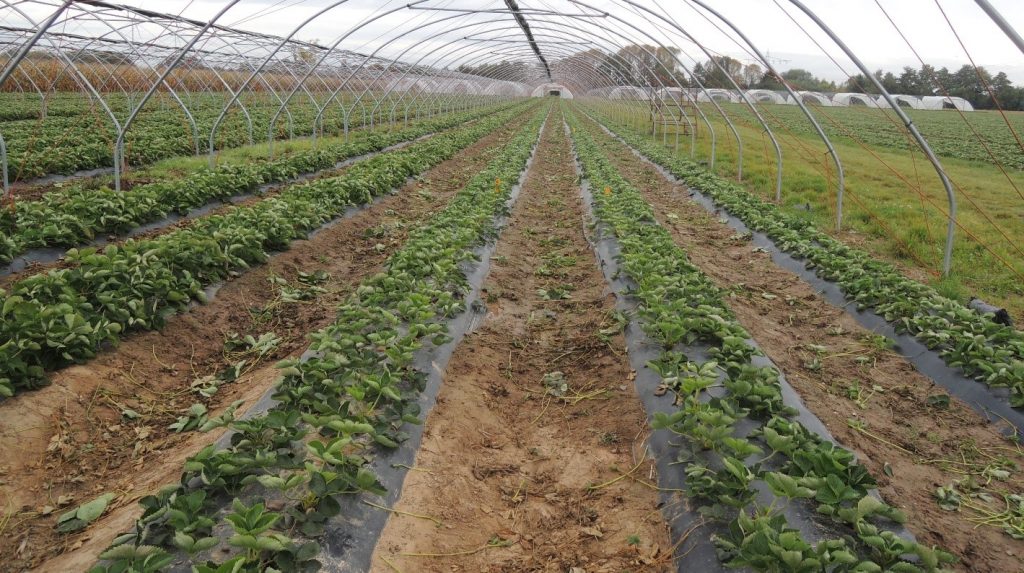In this post, Maximilian Meyer reports on his recently published paper “Agricultural mulching and fungicides—impacts on fungal biomass, mycotoxin occurrence, and soil organic matter decomposition”. The research question was – “Does plastic mulching mitigate fungicide effects in soils?”
Plastic or straw mulching?
Mulching means to cover the soil surface with materials such as straw or plastic films. This improves the growth conditions of plants, which can be due to an increased soil temperature and moisture, a suppressed weed growth and mitigated nutrient losses. Plastic mulching (PM) has largely replaced straw mulching (SM) because of better performance of the former. Nevertheless, SM is still applied today because of its low costs and labor intensity. Fungicides are frequently combined with PM and SM, e.g., in strawberry cultivation.

The influence of PM and SM on the entry of fungicides into soil is still a topic of research. However, it is important to understand how mulching can influence fungicide fate and soil quality. In this research, it was assumed that the plastic mulches act as physical barrier for fungicides. Barriers reduce fungicide entry into soil and thus affect the lower soil concentrations of fungicides compared to SM. Due to these reasons, PM and SM were expected to show different degrees of fungicide effects on microbial (fungal) biomass, mycotoxin occurrence, and soil organic matter (SOM) decomposition. These are considered as important attributes for soil quality and fertility.

Effects of plastic mulching?
Soil samples were taken in plastic- and straw-mulched plots of a strawberry cultivation. The samples were taken 1 month before fungicide treatments and 1 week, 5 weeks, and 4 months after the treatments. The fungicides Switch® (37.5% cyprodinil and 25% fludioxonil) and Teldor® (50% fenhexamid) were applied during strawberry bloom. The fungicides were also quantified with liquid chromatography–high-resolution mass spectrometry after solid-liquid extraction of soil. Furthermore, the soil was analyzed for mycotoxins (deoxynivalenol, 15-acetyldeoxynivalenol, nivalenol, and zearalenone) and proxies for SOM and microbial biomass (soil and dissolved organic C, soil microbial C and N, and ergosterol).
Fludioxonil and cyprodinil concentrations were up to three times higher under SM 1 week and 5 weeks after fungicide application. No differences were observed anymore after 4 months. Fenhexamid was not found, most likely because of its fast dissipation in soil. Higher fungicide concentrations under SM reduced the fungal biomass and shifted microbial community towards larger bacterial fraction in the topsoil. Additionally, higher concentrations of deoxynivalenol and 15-acetyldeoxynivalenol were found under SM 5 weeks after fungicide application. The SOM decomposition seemed temporarily reduced after fungicide application under both mulching types (independent from the different fungicide soil concentrations).
So did plastic mulching mitigate fungicide effects? As expected, PM reduced the fungicide entry into soil and mitigated the fungicide effects on fungal biomass and mycotoxins occurrence as compared to SM. Generally, the fungicide effects under both mulching types on microbial biomass, mycotoxin occurrence, and SOM decomposition were minor and short-lived (< 4 months) and seem thus not critical for long-term soil quality. However, further studies are needed to investigate what happens to the fungicide fractions retained by PM (runoff, adsorption or degradation?).
The paper was authored by Maximilian Meyer, Dörte Diehl, Gabriele Ellen Schaumann and Katherine Muñoz, and published in Environmental Science and Pollution Research.
